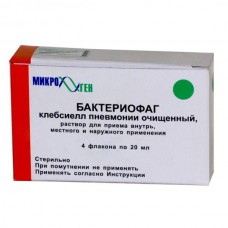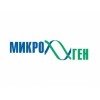Expiration date: 11/2026
Bacteriophage of Klebsiella pneumonia
Pharmacological group of the substance Bacteriophage Klebsiella pneumonia
Vaccines, serums, phages and anatoxins
Typical clinical and pharmacological article
Pharmacy. It has the ability to specifically lick the bacteria Klebsiella pneumonia.
Indications. Purulent inflammatory diseases of ENT organs (Ozen, rhinoscleroma) and gastrointestinal tract (gastroenterocolitis, cholecystitis, intestinal dysbacteriosis), surgical infections (purulent wounds, peritonitis, pleurisy, burn, mastitis, abscess), urogenital infections (cystitis, pyelonephritis, endometritis, salpingooophoritis), purulent inflammatory diseases of newborns and infants (omphalitis, pyoderma, sepsis). Selective intestinal decontamination in infection with nosocomial strains of Klebsiella pneumonia.
Contraindications. Hypersensitivity.
Dosing. Inside. Enterocolitis, intestinal dysbacteriosis-3 times a day for 1 hour before meals for 7-15 days. On 1 reception to 6 months-5ml, 6-12 months-10 ml, from 1 year to 3 years-15 ml, from 3 to 8 years-20 ml, from 8 years and older-30 ml. Cystitis, pyelonephritis, urethritis - for 10-20 days.
Rectally 1 time a day (in the form of enema) in combination with a double intake. On 1 reception to 6 months - 10 ml, 6-12 months-20 ml, from 1 year to 3 years-30 ml, from 3 to 8 years-40 ml, from 8 years and older-50 ml.
Locally for 7-20 days in the treatment of purulent inflammatory diseases with localized lesions in combination with oral administration. In the case of treatment of the cavity of the purulent focus with chemical antiseptics before using bacteriophage, the cavity is washed with a sterile 0, 9% NaCl solution.
Purulent wounds-in the form of irrigation, applications, bandages, introduction through drainage at least 1 time a day. In abscesses after opening and removing the purulent contents of the drug is administered in an amount smaller than the volume of removed pus. In the drained cavity daily once-20-200 ml.
Osteomyelitis — 10-30 ml into the cavity of the wound after turundas, drainage.
Purulent-inflammatory gynecological diseases-5-10 ml daily 1 time a day in the cavity of the vagina, uterus.
Purulent inflammatory diseases of ENT organs-2-10 ml 1-3 times a day in the middle ear, nose. Bacteriophage is used for rinsing, washing, instillation, introduction of moistened turund (leaving them for 1 hour).
Cystitis, pyelonephritis, urethritis — 20-50 ml in the bladder and 5-7 ml in the renal pelvis through a cystostomy or nephrostomy.
Children up to 6 months. Sepsis, enterocolitis of newborns, including premature infants, 2-3 times a day in the form of suppositories or high enemas (through a gas tube or catheter). In the absence of vomiting and regurgitation, the drug is used orally, mixing with breast milk. Perhaps a combination of rectal and oral administration of the drug. The course of treatment is 5-15 days, with a recurrent course of the disease, repeated courses of treatment are possible. For the prevention of sepsis and enterocolitis in utero infection or the risk of nosocomial infection in newborns klebsifag used in the form of suppositories or enemas 2 times a day for 5-7 days.
Omphalitis, pyoderma, infected wounds-2 times a day daily in the form of applications (gauze cloth moistened with bacteriophage and apply to the umbilical wound or affected skin).
Side effect. Not described.
Special instruction. The use of bacteriophage does not exclude the use of other drugs, including antibacterial and anti-inflammatory drugs.
An important condition for effective phage therapy is a preliminary determination of focustitle of the pathogen.


